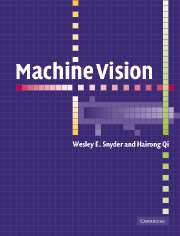Book contents
- Frontmatter
- Contents
- To the instructor
- Acknowledgements
- 1 Introduction
- 2 Review of mathematical principles
- 3 Writing programs to process images
- 4 Images: Formation and representation
- 5 Linear operators and kernels
- 6 Image relaxation: Restoration and feature extraction
- 7 Mathematical morphology
- 8 Segmentation
- 9 Shape
- 10 Consistent labeling
- 11 Parametric transforms
- 12 Graphs and graph-theoretic concepts
- 13 Image matching
- 14 Statistical pattern recognition
- 15 Clustering
- 16 Syntactic pattern recognition
- 17 Applications
- 18 Automatic target recognition
- Author index
- Index
18 - Automatic target recognition
Published online by Cambridge University Press: 05 June 2012
- Frontmatter
- Contents
- To the instructor
- Acknowledgements
- 1 Introduction
- 2 Review of mathematical principles
- 3 Writing programs to process images
- 4 Images: Formation and representation
- 5 Linear operators and kernels
- 6 Image relaxation: Restoration and feature extraction
- 7 Mathematical morphology
- 8 Segmentation
- 9 Shape
- 10 Consistent labeling
- 11 Parametric transforms
- 12 Graphs and graph-theoretic concepts
- 13 Image matching
- 14 Statistical pattern recognition
- 15 Clustering
- 16 Syntactic pattern recognition
- 17 Applications
- 18 Automatic target recognition
- Author index
- Index
Summary
Luke, you've switched off your targeting computer. What's wrong?
George LucasThis is the principal application chapter of this book. We have selected one application area: Automatic target recognition (ATR), and illustrate how the mathematics and algorithms previously covered are used in this application. The point to be made is that almost all applications similarly benefit from not one, but fusions of most of the techniques previously described. As in previous chapters, we provide the reader with both an explanation of concepts and pointers to more advanced literature. However, since this chapter emphasizes the application, we do not include a “Topics” section in this chapter.
Automatic target/object recognition (ATR) is the term given to the field of engineering sciences that deals with the study of systems and techniques designed to identify, to locate, and to characterize specific physical objects (referred to as targets) [18.7, 18.9, 18.69], usually in a military environment. Limited surveys of the field are available [18.3, 18.8, 18.21, 18.66, 18.74, 18.79, 18.89]. In this chapter, the only ATR systems considered are those that make use of images. Therefore, our use of terminology (e.g., clutter) will be restricted to terms that make sense in an imaging scenario.
The hierarchy of levels of ATR
In this section, we define a few popularly used terms and acronyms in the ATR [18.57] world, starting with the five levels in the ATR hierarchy.
Detection. Identifying the presence or absence of a target in a given scene.
Classification. This term, at least in Army parlance, originally meant distinguishing between vehicles with tracks and those with wheels.
- Type
- Chapter
- Information
- Machine Vision , pp. 392 - 416Publisher: Cambridge University PressPrint publication year: 2004



